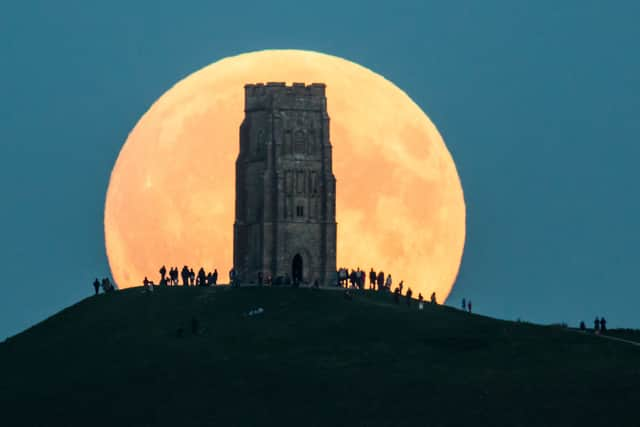When is the next supermoon? Are there any supermoons in 2024, what are they - and full moon dates
and live on Freeview channel 276
As we're treated to the first full moon of the year, you may be left wondering if January's 'Wolf Moon' is actually a beloved 'supermoon'.
Supermoons are those full moons that light up the night sky more than any others, and following such a celestial event, news sites and social media feeds are often awash with images of the moon towering over familiar landmarks.
Advertisement
Hide AdAdvertisement
Hide AdBut what exactly is a supermoon? How do they come about, and will we see any in 2024? Here is everything you need to know.
What is a supermoon?
The moon's orbit around Earth is not a perfect circle, and instead it follows an elliptical (or oval-shaped) orbit around the Earth. This means that at certain points on its egg-shaped path, it can be further away, or closer to us - a differential of about 30,000 miles.
A supermoon occurs when a full moon coincides with its closest approach to Earth in its elliptical orbit - called the perigee. Because the moon is closer, it appears larger in the night sky, and since it's fully illuminated by the sun, it looks brighter.
The moon's enhanced size - the diameter of the moon can appear to be about 14 per cent greater than an average full moon - is often its most striking feature.
Advertisement
Hide AdAdvertisement
Hide AdSome supermoons are less intense than others (depending on exactly how close the moon is to Earth), but while the human eye may struggle to discern a more subtle difference in size, the perceptible increase in brightness is often more noticeable. This luminosity is a result of the moon's proximity, allowing more sunlight to reflect off its surface and reach Earth.


How rare are Supermoons?
Supermoons are not rare events, but their occurrence depends on the specific definition used to classify them. Astronomers commonly designate a full moon as a supermoon if it occurs within 90% of its closest approach to Earth.
By this definition, several supermoons can occur in a single year, and observers can typically expect three to four supermoons within the year. However, the visual distinction between a supermoon and an average full moon may not always be noticeable to the casual observer.
Supermoons 2024
Yes. There will be two supermoons in 2024. These larger and brighter full moons will come with the full moons of September and October.
Advertisement
Hide AdAdvertisement
Hide AdThe full list of exact dates for the full moons of 2024 - and their 'traditional' names - is below, complete with which ones are supermoons.
- Wolf Moon on Thursday 25 January
- Snow Moon on Saturday 24 February
- Worm Moon on Monday 25 March
- Pink Moon on Wednesday 24 April
- Flower Moon on Thursday 23 May
- Strawberry Moon on Saturday 22 June
- Buck Moon on Sunday 21 July
- Sturgeon Moon on Monday 19 August
- Harvest Moon on Wednesday 18 September (SUPERMOON)
- Hunter’s Moon Thursday 17 October (SUPERMOON)
- Frost Moon on Friday 15 November
- Cold Moon on Sunday 15 December
Best way to see supermoon
For the best effect – and the closest you’ll get to witnessing the spectacular images seen across social media following such an event – you’ll want to look east shortly after moonrise.
“When the moon is near the horizon, it can look unnaturally large when viewed through trees, buildings or other foreground objects," says NASA. "The effect is an optical illusion, but that fact doesn’t take away from the experience."
That illusion, helpfully known as the Moon Illusion, makes the moon seem even larger when it is near the horizon, because it is viewed in relation to foreground objects like trees, buildings or hills.
Advertisement
Hide AdAdvertisement
Hide AdThe presence of these objects provides visual cues for our brains to compare the size of the moon to familiar reference points on the Earth's surface. As a result, our brains interpret the moon as being larger than when it is higher up in the sky with no nearby reference points.
Comment Guidelines
National World encourages reader discussion on our stories. User feedback, insights and back-and-forth exchanges add a rich layer of context to reporting. Please review our Community Guidelines before commenting.
